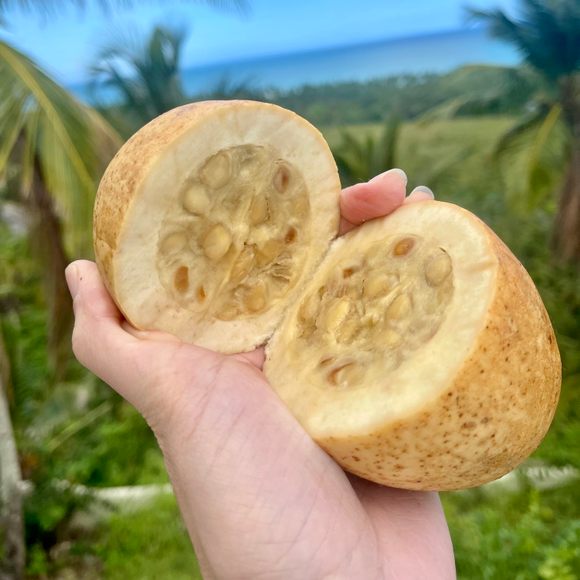In Central and South America, the jagua fruit is a temporary tattoo ink, a cure-all, and a dessert.
This yellow-orange fruit ranges in size from kiwi to melon, and tastes like dried apple or quince when ripe. Central and South Americans use jagua in sweets, wine, syrups, and liquor, but—most specifically—for its vibrant natural dye. Unripe jagua produces colorless juice. When exposed to air, the liquid oxidizes and transforms from light brown to blue-black to jet black. The resulting pigment stains surfaces for up to 20 days.
Isolated tribes across regions such as present-day Panama, Colombia, Peru, and Brazil have used jagua for centuries. Each group developed a set of tools and techniques for dyeing skin, utensils, basket fibers, and cloth. In addition to face and body adornment, South and Central Americans used jagua as an insect repellant. Indigenous people bathed in the clear juice, which, according to an 18th-century explorer, “turned everything it touched as black and fine as polished jet.” He also noted men spiking perfume with unoxidized jagua juice, then sprinkling it on unsuspecting women. As the juice oxidized, spots appeared—a rather alarming, long-lasting practical joke.
Beyond the fruit’s unique pigment, Central and South American people use jagua for medicinal purposes. It’s a diuretic, an antibiotic, and, in large quantities, is said to kill parasites. El Salvadoreans eat jagua as a remedy for jaundice. Puerto Ricans steep the chopped fruit until lightly fermented, then create a cold remedy from the infusion. Guatemalan Indians even carry jagua to ward off ill-fortune and disease.
Westerners, only recently privy to jagua’s existence, have adopted the juice as a natural, safe tattoo ink. Mixing it with henna powder, temporary tattoo artists combine traditional Indian wedding–style art with the rich tones of jagua dye. Before committing to permanent ink, tattoo-seekers can test out a desired piece by commissioning a jagua rendition first. Even if the body art doesn’t work out, at least they’ve warded off bugs and bacteria.
Written By
 rachelrummel
rachelrummel
Sources
- www.fondazioneslowfood.com/en/ark-of-taste-slow-food/jagua/
- www.hort.purdue.edu/newcrop/morton/genipap.html
- medicinalplants.us/genipa-americana-l-marmalade-box
- www.mehndimadness.com/historyofjagua.asp
- books.google.com/books?id=A2fvCAAAQBAJ&pg=PA162&lpg=PA162&dq=(Oviedo+18th+century)+genipa&source=bl&ots=VPLVfn_4wT&sig=ixJ-LoPRg3Uc9rAOUHy1YN_GBbw&hl=en&sa=X&ved=0ahUKEwji09nu8vXXAhXBQBQKHW4LDwUQ6AEIRDAI#v=onepage&q=(Oviedo%2018th%20century)%20genipa&f=false


















